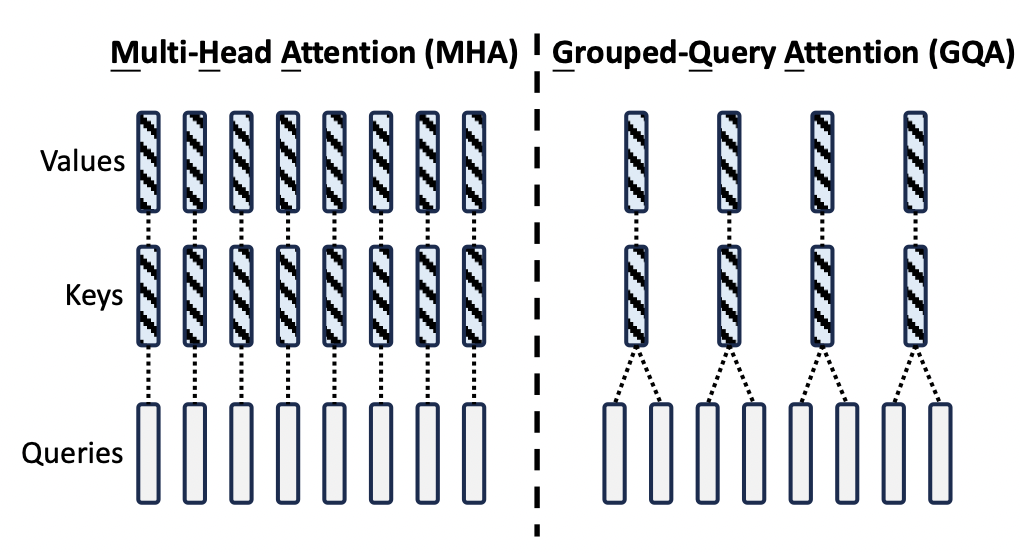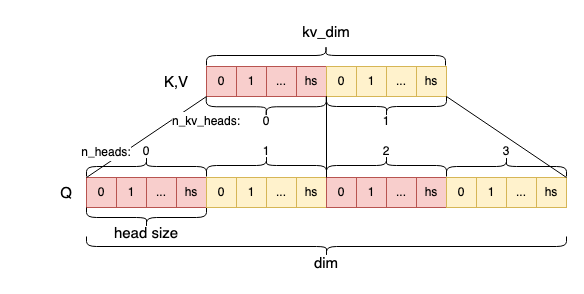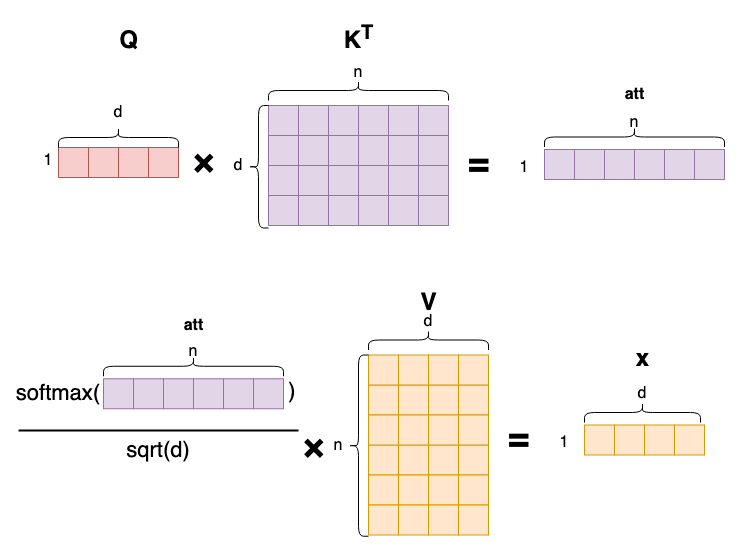1. 概述
前OpenAI著名工程师Andrej Kapathy开源了llama2.c项目,该项目是llama2模型推理代码的C语言实现,用大概970行C代码实现了LLama2模型的推理算法。整个项目代码简洁高效,值得深度阅读。对掌握大模型推理算法的细节有极大的帮助。
2. 源码阅读
2.1 基础算法
RMS归一化公式是:
$$ o_i = w_i \times x_i \times \frac {1}{\sqrt{\frac{1}{n}\sum_{j=0}^{n-1} x_j^2 + \epsilon}} $$其中,\(\epsilon\) 为防止分母为0的数值。还有RMS因子是对x的归一化,w变量是gain变量,重新缩放标准化后的输入向量。
// ----------------------------------------------------------------------------
// neural net blocks; the dynamics of the Transformer
void rmsnorm(float* o, float* x, float* weight, int size) {
// calculate sum of squares
float ss = 0.0f;
for (int j = 0; j < size; j++) {
ss += x[j] * x[j];
}
ss /= size;
ss += 1e-5f;
ss = 1.0f / sqrtf(ss);
// normalize and scale
for (int j = 0; j < size; j++) {
o[j] = weight[j] * (ss * x[j]);
}
}
softmax函数公式是:
$$ o_i = \frac {e^{x_i-x_{max}}}{\sum_{j=0}^{n-1} e^{x_j-x_{max}}} $$代码如下,注释说的很清楚,减去最大值是为了防止数值溢出,数值更稳定。通过简单数学变换可以得知,最终结果不变。
void softmax(float* x, int size) {
// find max value (for numerical stability)
float max_val = x[0];
for (int i = 1; i < size; i++) {
if (x[i] > max_val) {
max_val = x[i];
}
}
// exp and sum
float sum = 0.0f;
for (int i = 0; i < size; i++) {
x[i] = expf(x[i] - max_val);
sum += x[i];
}
// normalize
for (int i = 0; i < size; i++) {
x[i] /= sum;
}
}
W (d,n) @ x (n,) -> xout (d,)的矩阵乘法,采用naive的矩阵乘法,即外层循环是行,内层循环是列。代码如下:
void matmul(float* xout, float* x, float* w, int n, int d) {
// W (d,n) @ x (n,) -> xout (d,)
// by far the most amount of time is spent inside this little function
int i;
#pragma omp parallel for private(i)
for (i = 0; i < d; i++) {
float val = 0.0f;
for (int j = 0; j < n; j++) {
val += w[i * n + j] * x[j];
}
xout[i] = val;
}
}
2.2. forward计算
模型中一个attention block的计算如下图所示:

项目代码是按照每一个token来计算QKV的,其中参数dim是transformer的向量维度。l是layer序号。
第一步是rmsnorm,即归一化。输入是x (d,),rms权重向量是w->rms_att_weight + l*dim,计算结果输出到s->xb (d,)中。
// attention rmsnorm
rmsnorm(s->xb, x, w->rms_att_weight + l*dim, dim);
第二步是QKV的矩阵乘法,注意kv_dim和dim的区别,是为了同时兼容multi head attention和grouped query attention两种算法。如下图所示:

kv_dim是key和value的总维度,dim是transformer的向量总维度。在multi head attention中,kv_dim = dim。在grouped query attention中,kv_dim = dim * n_kv_heads / n_heads。以图中为例,n_kv_heads = 4, n_heads = 8,则kv_dim = dim / 2。
对于各矩阵的维度,以及在MHA、GQA等算法中的关系,参考下图:

Q、K、V三个向量计算的详细代码如下,即Wq(d,d) @ xb(d,) -> q(d,),Wk(dkv,d) @ xb(d,) -> k(dkv,), Wv(dkv,d) @ xb(d,) -> v(dkv,)
// key and value point to the kv cache
int loff = l * p->seq_len * kv_dim; // kv cache layer offset for convenience
s->k = s->key_cache + loff + pos * kv_dim;
s->v = s->value_cache + loff + pos * kv_dim;
// qkv matmuls for this position
matmul(s->q, s->xb, w->wq + l*dim*dim, dim, dim);
matmul(s->k, s->xb, w->wk + l*dim*kv_dim, dim, kv_dim);
matmul(s->v, s->xb, w->wv + l*dim*kv_dim, dim, kv_dim);
接下来需要给Q和K向量添加RoPE位置编码,按照如下公式计算,其中m就是当前token的序号pos。需要注意的是,llama模型是给每一层的Q和K向量都添加这个编码。
$$ \begin{aligned} \theta_i &= \frac{1}{10000^{2i/hs}}= 10000^{-2i/hs} \\ Q(i) &=Q(i)\cos (m\theta_i) - Q(i+1)\sin(m\theta_i)\\ Q(i+1) &=Q(i)\sin (m \theta_i) + Q(i+1)\cos(m\theta_i)\\ K(i) &=K(i)\cos (m \theta_i) - K(i+1)\sin(m\theta_i)\\ K(i+1) &=K(i)\sin (m \theta_i) + K(i+1)\cos(m\theta_i)\\ \end{aligned} $$详细代码如下,注意在GQA中,K的向量长度小于Q的向量长度,所以在i < kv_dim时,计算Q和K的向量。在i >= kv_dim时,只计算Q的向量。
// RoPE relative positional encoding: complex-valued rotate q and k in each head
for (int i = 0; i < dim; i+=2) {
int head_dim = i % head_size;
float freq = 1.0f / powf(10000.0f, head_dim / (float)head_size);
float val = pos * freq;
float fcr = cosf(val);
float fci = sinf(val);
int rotn = i < kv_dim ? 2 : 1; // how many vectors? 2 = q & k, 1 = q only
for (int v = 0; v < rotn; v++) {
float* vec = v == 0 ? s->q : s->k; // the vector to rotate (query or key)
float v0 = vec[i];
float v1 = vec[i+1];
vec[i] = v0 * fcr - v1 * fci;
vec[i+1] = v0 * fci + v1 * fcr;
}
}
接下来针对每个头,计算attention score。attention score的计算公式如下:
$$ score(i) = softmax(\frac{ Q_i K^T}{\sqrt{d}})V , \quad Q_i \in \R^{1 \times d},K \in \R^{n\times d},V\in\R^{n\times d} $$具体计算的时候,先遍历每个head,在每个head中,先计算Qi和K的点积,然后除以sqrt(d),得到att (1,n)向量,最后softmax得到attention score。
在GQA中,由于分组共享了Q和K的向量,在计算attention score的时候,需要把Q和K的向量“展开”还原为(n,d)的矩阵,具体做法是通过h / kv_mul,保证 kv_mul个Q和K向量共享一个权重。
然后计算attention score (1,n)和V (n,d)的乘积,得到xb (1,d)。这个计算并不是完全按照普通矩阵乘来计算的,而是把每个位置的attention score和V的 每一行相乘,然后累加到xb中。这样计算的好处是对cache更加友好,是一种常见的矩阵乘算法。
对于每个头,每个token的attention score计算过程的可视化如图所示:

图中可以清楚看出,每个token都计算了一遍和其他token的相关度,再进行加权求和得到最终的attention score。
具体代码如下:
for (h = 0; h < p->n_heads; h++) {
// get the query vector for this head
float* q = s->q + h * head_size;
// attention scores for this head
float* att = s->att + h * p->seq_len;
// iterate over all timesteps, including the current one
for (int t = 0; t <= pos; t++) {
// get the key vector for this head and at this timestep
float* k = s->key_cache + loff + t * kv_dim + (h / kv_mul) * head_size;
// calculate the attention score as the dot product of q and k
float score = 0.0f;
for (int i = 0; i < head_size; i++) {
score += q[i] * k[i];
}
score /= sqrtf(head_size);
// save the score to the attention buffer
att[t] = score;
}
// softmax the scores to get attention weights, from 0..pos inclusively
softmax(att, pos + 1);
// weighted sum of the values, store back into xb
float* xb = s->xb + h * head_size;
memset(xb, 0, head_size * sizeof(float));
for (int t = 0; t <= pos; t++) {
// get the value vector for this head and at this timestep
float* v = s->value_cache + loff + t * kv_dim + (h / kv_mul) * head_size;
// get the attention weight for this timestep
float a = att[t];
// accumulate the weighted value into xb
for (int i = 0; i < head_size; i++) {
xb[i] += a * v[i];
}
}
}
从代码中也能看出,为什么需要把K和V的矩阵进行cache。因为对于一个位置的token而言,Q矩阵每次参与计算的只有当前位置的一行,而K和V矩阵,则是每行都需要 参与计算。最终得到的也是该位置的(1,d)向量作为attention score。因此,为了减少计算量,把K和V矩阵进行cache也是理所当然。
接下来的计算就非常简单,注释也非常直观。详细步骤如下:
- 计算Wo (d,d) @ xb^T (d,)得到xb2 (d,)
- 通过残差连接,叠加x (d,)向量:x += xb2
- x再经过一个RMSNorm(x),得到xb (d,)
- 计算hb和hb2:W1(hd, d) @ xb (d,) -> hb1(hd,) , W3(hd, d) @ xb (d,) -> hb2(hd, )
- hb经过silu非线性激活函数变换,计算方式为:$$silu(hb) = hb (1/ (1 + e^{-hb}))$$
- 然后计算逐位相乘 hb * hb2, 得到hb (hd,)
- 计算W2(d, hd) @ hb (hd,) -> xb (d,)
- 最终再通过残差连接,叠加xb向量:x += xb
// final matmul to get the output of the attention
matmul(s->xb2, s->xb, w->wo + l*dim*dim, dim, dim);
// residual connection back into x
for (int i = 0; i < dim; i++) {
x[i] += s->xb2[i];
}
// ffn rmsnorm
rmsnorm(s->xb, x, w->rms_ffn_weight + l*dim, dim);
// Now for FFN in PyTorch we have: self.w2(F.silu(self.w1(x)) * self.w3(x))
// first calculate self.w1(x) and self.w3(x)
matmul(s->hb, s->xb, w->w1 + l*dim*hidden_dim, dim, hidden_dim);
matmul(s->hb2, s->xb, w->w3 + l*dim*hidden_dim, dim, hidden_dim);
// SwiGLU non-linearity
for (int i = 0; i < hidden_dim; i++) {
float val = s->hb[i];
// silu(x)=x*σ(x), where σ(x) is the logistic sigmoid
val *= (1.0f / (1.0f + expf(-val)));
// elementwise multiply with w3(x)
val *= s->hb2[i];
s->hb[i] = val;
}
// final matmul to get the output of the ffn
matmul(s->xb, s->hb, w->w2 + l*dim*hidden_dim, hidden_dim, dim);
// residual connection
for (int i = 0; i < dim; i++) {
x[i] += s->xb[i];
}
继续每一层的计算,每一层的输入都是x,输出也是x,循环计算。在每一层都算完以后,最后再计算:
- RMSNorm(x),把x向量进行归一化。
- 计算Wc(dvoc, d) @ x (d,) -> logits (dvoc,),其中dvoc为词典大小。
至此,最终得到的logits就是该位置的在token词典中的分类概率。
// final rmsnorm
rmsnorm(x, x, w->rms_final_weight, dim);
// classifier into logits
matmul(s->logits, x, w->wcls, p->dim, p->vocab_size);
return s->logits;
2.3 抽样方法
拿到logits之后,需要通过抽样来最终确定输出哪个token,常见的抽样方法有greedy(argmax),随机抽样,以及top-p (nucleus) 抽样。
2.3.1 Greedy Sampling
Greedy Sampling是直接选择概率最大的token作为输出。代码简单直观,如下:
int sample_argmax(float* probabilities, int n) {
// return the index that has the highest probability
int max_i = 0;
float max_p = probabilities[0];
for (int i = 1; i < n; i++) {
if (probabilities[i] > max_p) {
max_i = i;
max_p = probabilities[i];
}
}
return max_i;
}
2.3.2 Random Sampling
Random Sampling是随机选择一个token作为输出。代码也很简单,如下:
int sample_mult(float* probabilities, int n, float coin) {
// sample index from probabilities (they must sum to 1!)
// coin is a random number in [0, 1), usually from random_f32()
float cdf = 0.0f;
for (int i = 0; i < n; i++) {
cdf += probabilities[i];
if (coin < cdf) {
return i;
}
}
return n - 1; // in case of rounding errors
}
2.3.3 Top-p (Nucleus) Sampling
Top-p (Nucleus) Sampling是随机选择概率大于某个阈值的token作为输出。代码也很简单,如下:
int sample_topp(float* probabilities, int n, float topp, ProbIndex* probindex, float coin) {
// top-p sampling (or "nucleus sampling") samples from the smallest set of
// tokens that exceed probability topp. This way we never sample tokens that
// have very low probabilities and are less likely to go "off the rails".
// coin is a random number in [0, 1), usually from random_f32()
int n0 = 0;
// quicksort indices in descending order of probabilities
// values smaller than (1 - topp) / (n - 1) cannot be part of the result
// so for efficiency we crop these out as candidates before sorting
const float cutoff = (1.0f - topp) / (n - 1);
for (int i = 0; i < n; i++) {
if (probabilities[i] >= cutoff) {
probindex[n0].index = i;
probindex[n0].prob = probabilities[i];
n0++;
}
}
qsort(probindex, n0, sizeof(ProbIndex), compare);
// truncate the list where cumulative probability exceeds topp
float cumulative_prob = 0.0f;
int last_idx = n0 - 1; // in case of rounding errors consider all elements
for (int i = 0; i < n0; i++) {
cumulative_prob += probindex[i].prob;
if (cumulative_prob > topp) {
last_idx = i;
break; // we've exceeded topp by including last_idx
}
}
// sample from the truncated list
float r = coin * cumulative_prob;
float cdf = 0.0f;
for (int i = 0; i <= last_idx; i++) {
cdf += probindex[i].prob;
if (r < cdf) {
return probindex[i].index;
}
}
return probindex[last_idx].index; // in case of rounding errors
}
2.3.4 选择抽样策略
具体执行抽样前,需要做一些变换,比如:
- 除以temperature,用来调整概率分布,温度越高,概率分布越平滑
- 计算softmax(logits),得到概率分布 代码如下所示:
// apply the temperature to the logits
for (int q=0; q<sampler->vocab_size; q++) { logits[q] /= sampler->temperature; }
// apply softmax to the logits to get the probabilities for next token
softmax(logits, sampler->vocab_size);
然后根据不同的采样策略,选择不同的采样函数。
2.4 encode和decode
2.4.1 encode
encode函数将输入文本转化为token id序列。token id为int类型,长度为max_len。encode算法非常直观,先是在tokenize词典中查询每个UTF-8字符。如果找不到,则将文本编码为byte fallback。注意每个UTF-8字符长度是1到3个字节之间,需要针对UTF-8编码的规范进行判断。
代码如下:
// process the raw (UTF-8) byte sequence of the input string
for (char *c = text; *c != '\0'; c++) {
// reset buffer if the current byte is ASCII or a leading byte
// 0xC0 is 11000000, so (*c & 0xC0) keeps the first 2 bits and zeros the rest
// 0x80 is 10000000
// in UTF-8, all continuation bytes start with "10" in first two bits
// so in English this is: "if this byte is not a continuation byte"
if ((*c & 0xC0) != 0x80) {
// this byte must be either a leading byte (11...) or an ASCII char (0x...)
// => reset our location, as we're starting a new UTF-8 codepoint
str_len = 0;
}
// append the current byte to the buffer
str_buffer[str_len++] = *c; // ++ is post-increment, incremented after this line
str_buffer[str_len] = '\0';
// while the next character is a continuation byte, continue appending
// but if there are too many of them, just stop to avoid overruning str_buffer size.
if ((*(c+1) & 0xC0) == 0x80 && str_len < 4) {
continue;
}
// ok c+1 is not a continuation byte, so we've read in a full codepoint
int id = str_lookup(str_buffer, t->sorted_vocab, t->vocab_size);
if (id != -1) {
// we found this codepoint in vocab, add it as a token
tokens[(*n_tokens)++] = id;
} else {
// byte_fallback encoding: just encode each byte as a token
// +3 is here because the first 3 vocab elements are <unk>, <s>, </s>
// so the individual bytes only start at index 3
for (int i=0; i < str_len; i++) {
tokens[(*n_tokens)++] = (unsigned char)str_buffer[i] + 3;
}
}
str_len = 0; // protect against a sequence of stray UTF8 continuation bytes
}
其次,尝试合并临近的字符,并查询tokenize词典,如果存在,则将临近的token缩对应的字符串合并为一个token。 并反复迭代,直到找不到相邻的两个token可以合并为一个token为止。代码也很直观,如下:
// merge the best consecutive pair each iteration, according the scores in vocab_scores
while (1) {
float best_score = -1e10;
int best_id = -1;
int best_idx = -1;
for (int i=0; i < (*n_tokens-1); i++) {
// check if we can merge the pair (tokens[i], tokens[i+1])
sprintf(str_buffer, "%s%s", t->vocab[tokens[i]], t->vocab[tokens[i+1]]);
int id = str_lookup(str_buffer, t->sorted_vocab, t->vocab_size);
if (id != -1 && t->vocab_scores[id] > best_score) {
// this merge pair exists in vocab! record its score and position
best_score = t->vocab_scores[id];
best_id = id;
best_idx = i;
}
}
if (best_idx == -1) {
break; // we couldn't find any more pairs to merge, so we're done
}
// merge the consecutive pair (best_idx, best_idx+1) into new token best_id
tokens[best_idx] = best_id;
// delete token at position best_idx+1, shift the entire sequence back 1
for (int i = best_idx+1; i < (*n_tokens-1); i++) {
tokens[i] = tokens[i+1];
}
(*n_tokens)--; // token length decreased
}
2.4.2 decode
decode函数将token id序列转化为文本。代码也直观,有一些比较tricky之处,代码也注释清楚:
char* decode(Tokenizer* t, int prev_token, int token) {
char *piece = t->vocab[token];
// following BOS (1) token, sentencepiece decoder strips any leading whitespace (see PR #89)
if (prev_token == 1 && piece[0] == ' ') { piece++; }
// careful, some tokens designate raw bytes, and look like e.g. '<0x01>'
// parse this and convert and return the actual byte
unsigned char byte_val;
if (sscanf(piece, "<0x%02hhX>", &byte_val) == 1) {
piece = (char*)t->byte_pieces + byte_val * 2;
}
return piece;
}
2.5 文本生成
文本生成是最基础的inference逻辑,对话也是基于文本生成而实现的。整个代码逻辑也非常简单:
- 将每一个token id逐个进行forward计算
- 判断当前token位置是否还在prompt长度内,如果不在则执行sampling策略,通过logits向量选取下一个token
- 否则直接从prompt中读取下一个token。
- 将下一个token进行decode,并打印出来。
代码详见:
while (pos < steps) {
// forward the transformer to get logits for the next token
float* logits = forward(transformer, token, pos);
// advance the state machine
if (pos < num_prompt_tokens - 1) {
// if we are still processing the input prompt, force the next prompt token
next = prompt_tokens[pos + 1];
} else {
// otherwise sample the next token from the logits
next = sample(sampler, logits);
}
pos++;
// data-dependent terminating condition: the BOS (=1) token delimits sequences
if (next == 1) { break; }
// print the token as string, decode it with the Tokenizer object
char* piece = decode(tokenizer, token, next);
safe_printf(piece); // same as printf("%s", piece), but skips "unsafe" bytes
fflush(stdout);
token = next;
// init the timer here because the first iteration can be slower
if (start == 0) { start = time_in_ms(); }
}
2.6 其他
其他部分的代码就是一些简单的数据结构定义,以及helper函数和main函数,这里就不再赘述了。
3. 总结
总体来说,这个项目是一个toy项目,代码逻辑比较简单,但是也提供了非常多的细节参考。特别是兼容了MHA和GQA算法,对于理解这些算法的原理非常有帮助。
但也要看出,这个代码中并没有实现prefill阶段,而是采用逐个token输入的方式填充kv cache。效率的确比较低,但好在逻辑清晰,容易理解。
如果需要进一步优化这个代码,其实有很多可优化点,例如prefill的并行加载优化,减少重复decode等,但这些都超出了这个项目的范围,留给读者自己探索。